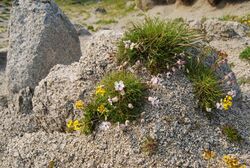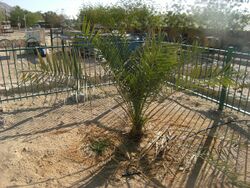Biology:Oldest viable seed

There have been several seeds known at different times as the oldest viable seed.
Dormancy allows seeds to survive for extended periods, which can aid in seed dispersal and spread out the growth and establishment of seedlings, increasing the likelihood that some of the next generations survive if conditions are not suitable for seedling establishment. Over time, seeds lose viability which is the ability to initiate metabolic activity, cellular growth, and germination. Seeds have many cells and tissues that die over time,[1] and these deaths can be delayed or increased by environmental conditions the seed experiences. Very generally, small seeds, especially from weedy species and annuals are more likely to remain viable in the soil longer than larger perennial seeds.[2] The seeds of some aquatic plants also may remain viable longer in mud because their viability is aided by the aquatic environment which remains cool and moist.[2]
Carbon-dated
- The oldest viable seed that has grown into a full plant was an about 2,000 years old Judean date palm seed, recovered from excavations at Herod the Great's palace on Masada in Israel. It had been preserved in a cool, dry place, not by freezing. It was germinated in 2005.[3][4][5][6] (Further information: Judean date palm: Germination of 2000-year-old seeds)
- The second oldest viable seed recorded is the carbon-14-dated 1,300-year-old sacred lotus (Nelumbo nucifera), recovered from a dry lake bed in northeastern China in 1995.[7][8]
Anecdotal
- In December, 2009, a Turkish newspaper reported a claim that a 4,000-year-old lentil had been successfully germinated.[9]
- In 1954, arctic lupine seeds belonging to the species Lupinus arcticus were found in the Yukon Territory in glacial sediments, believed to be at least 10,000 years old. The seeds were germinated in 1966. Later, new dating techniques revealed that they were likely modern seeds (less than 10 years old) contaminating ancient rodent burrows.[10][11]
- There was a persistent myth that seeds from Ancient Egyptian tombs were viable. The myth was reportedly started by scam artists selling "miracle seed" designed to capitalize on European Egyptomania of the 1800s. In 1897, the claims were tested by the British Museum's director of Egyptian antiquities, E. A. Wallis Budge. Budge provided genuine 3,000-year-old tomb grains of wheat to the director of Royal Botanic Gardens, Kew, William Thiselton-Dyer to plant under controlled conditions. The test resulted in none germinating.[12]
Miscellaneous
- The oldest carbon-14-dated plant tissue that has grown into a viable adult plant was a Silene stenophylla (narrow-leafed campion), an Arctic flower native to Siberia. The plants were not grown from seeds because they were not viable, but the placental tissue of three fruits.[13] Radiocarbon dating has confirmed an age of 31,800 ±300 years for the seeds. In 2007, more than 600,000 frozen mature and immature S. stenophylla seeds were found buried in 70 squirrel hibernation burrows 38 metres (125 ft) below the permafrost near the banks of the Kolyma River. The Arctic ground squirrels (Urocitellus parryii) believed to have buried and damaged the mature seeds to prevent germination in the burrow, but three of the immature seeds contained viable placenta tissue, which was successfully grown in vitro. The plants grew, flowered and created viable seeds of their own. The shape of the flowers differed from that of modern S. stenophylla plants with the petals being longer and more widely spaced than modern versions of the plant. Seeds produced by the regenerated plants germinated at a 100% success rate, compared with 90% for modern plants. Calculations of the gamma radiation dose (in grays; Gy) accumulated by the seeds since burial gave a reading of 0.07 kilograys (70 Gy), the highest dose recorded for seeds.[14][15][13]
See also
References
- ↑ Copeland, Larry O.; Copeland, Lawrence O.; McDonald, Miller; McDonald, Miller F. (1995-10-31). Principles of Seed Science and Technology. Springer Science & Business Media. ISBN 9780412063015. OCLC 31132765. https://books.google.com/books?id=nKpdPsO3CzIC&pg=PA111.
- ↑ Jump up to: 2.0 2.1 Gibson, J. Phil; Gibson, Terri R. (2006). Plant Ecology. Infobase Publishing. ISBN 9781438107028. OCLC 613206385. https://books.google.com/books?id=hKUbAUKlca8C&pg=PA122.
- ↑ Sallon, Sarah; Solowey, E.; Cohen, Y.; Korchinsky, R.; Egli, M.; Woodhatch, I.; Simchoni, O.; Kislev, M. (2008-06-13). "Germination, Genetics, and Growth of an Ancient Date Seed". Science 320 (5882): 1464. doi:10.1126/science.1153600. PMID 18556553. Bibcode: 2008Sci...320.1464S. https://www.science.org/doi/abs/10.1126/science.1153600. Retrieved 2010-02-03.
- ↑ Roach, John (2005-11-22). "2,000-Year-Old Seed Sprouts, Sapling Is Thriving". National Geographic Society. http://news.nationalgeographic.com/news/2005/11/1122_051122_old_seed.html. "A sapling germinated earlier this year from a 2,000-year-old date palm seed is thriving, according to Israeli researchers who are cultivating the historic plant. "It's 80 centimeters [3 feet] high with nine leaves, and it looks great," said Sarah Sallon, director of the Hadassah Medical Organization's Louis L. Borick Natural Medicine Research Center (NMRC) in Jerusalem."
- ↑ Moskowitz, Clara (2008-06-12). "Extinct Tree From Christ's Time Rises From the Dead". LiveScience. http://www.livescience.com/history/080612-methuselah-tree.html. Retrieved 2010-02-03. "Carbon dating of the seeds found at Masada revealed that they date from roughly the time of the ancient fortress' siege, in A.D. 73. The seeds were found in storage rooms, and appear to have been stockpiled for the Jews hiding out against the invading Romans. ... The seeds were excavated about 40 years ago, along with skeletons of those who died during the siege. Since then, the seeds had been languishing in a drawer until Sallon and her team decided to attempt to grow them anew. ... Though a few trees have been planted from seeds that are rumored to be older than the Masada ones, the Methuselah tree holds the record for the oldest directly dated seed to be germinated. Scientists determined its age from control seeds taken from the same batch, and from shell fragments from the sprouted seed itself."
- ↑ Erlanger, Steven (2005-06-12). "After 2,000 Years, a Seed From Ancient Judea Sprouts". New York Times. https://www.nytimes.com/2005/06/12/international/middleeast/12palm.html?_r=1. Retrieved 2010-02-03. "Israeli doctors and scientists have succeeded in germinating a date seed nearly 2,000 years old. The seed, nicknamed Methuselah, was taken from an excavation at Masada, the cliff fortress where, in A.D. 73, 960 Jewish zealots died by their own hand, rather than surrender to a Roman assault. The point is to find out what was so exceptional about the original date palm of Judea, much praised in the Bible and the Koran for its shade, food, beauty and medicinal qualities, but long ago destroyed by the crusaders. [Correction: June 15, 2005, Wednesday: An article on Sunday about the successful germination of a 2,000-year-old date seed by Israeli doctors and scientists referred incorrectly to the Koran's mentions of the date palm. They were to the tree in general, not to the date palm of Judea. The article also misstated the timing of the Crusades, when the date palms of Judea were destroyed. The Crusades took place during the Middle Ages, not before.]"
- ↑ Shen-Miller; Mudgett, M. B.; William Schopf, J.; Clarke, S.; Berger, R. (1995). "Exceptional seed longevity and robust growth: Ancient sacred lotus from China". American Journal of Botany 82 (11): 1367–1380. doi:10.2307/2445863. https://www.jstor.org/stable/2445863.
- ↑ Shen-Miller, J.; Mudgett, Mary B.; Schopf, J. W.; Steven, Clarke; Rainer, Berger (2002). "Long-living lotus: germination and soil gamma-irradiation of centuries-old fruits, and cultivation, growth, and phenotypic abnormalities of offspring". American Journal of Botany. http://www.amjbot.org/cgi/content/abstract/89/2/236. Retrieved 2010-02-03. "Sacred lotus (Nelumbo nucifera) has been cultivated as a crop in Asia for thousands of years. An ~1300-yr-old lotus fruit, recovered from an originally cultivated but now dry lakebed in northeastern China, is the oldest germinated and directly 14C-dated fruit known. In 1996, we traveled to the dry lake at Xipaozi Village, China, the source of the old viable fruits."
- ↑ "Ancient seed sprouts plant from the past". Hürriyet Daily News & Economic Review. 2009-12-16. http://www.hurriyetdailynews.com/n.php?n=ancient-seed-came-into-leaf-2009-12-16. Retrieved 2010-02-03.
- ↑ Zazula Grant D (2009). "Radiocarbon dates reveal thatLupinus arcticusplants were grown from modern not Pleistocene seeds". New Phytologist 182 (4): 788–792. doi:10.1111/j.1469-8137.2009.02818.x. PMID 19383097.
- ↑ Walker, Matt (2009-07-09). "'10,000-year-old' seeds debunked". BBC. http://news.bbc.co.uk/earth/hi/earth_news/newsid_8142000/8142037.stm. Retrieved 2010-02-03.
- ↑ Moshenska, Gabriel (2017-09-09). "The Myth of Mummy Wheat | History Today". https://www.historytoday.com/archive/myth-mummy-wheat.
- ↑ Jump up to: 13.0 13.1 "Plant grown from 30,000 year-old seeds". ABC Science; Agence France-Presse (AFP). 2012-02-22. https://www.abc.net.au/science/articles/2012/02/22/3436826.htm.
- ↑ Yashina, S.; Gubin, S.; Maksimovich, S.; Yashina, A.; Gakhova, E.; Gilichinsky, D. (March 2012). "Regeneration of whole fertile plants from 30,000-y-old fruit tissue buried in Siberian permafrost". Proceedings of the National Academy of Sciences of the United States of America 109 (10): 4008–4013. doi:10.1073/pnas.1118386109. PMID 22355102. Bibcode: 2012PNAS..109.4008Y.
- ↑ Kaufman, Rachel (2012-02-23). "32,000-Year-Old Plant Brought Back to Life—Oldest Yet". National Geographic Society News. http://news.nationalgeographic.com.au/news/2012/02/120221-oldest-seeds-regenerated-plants-science/.
 |



